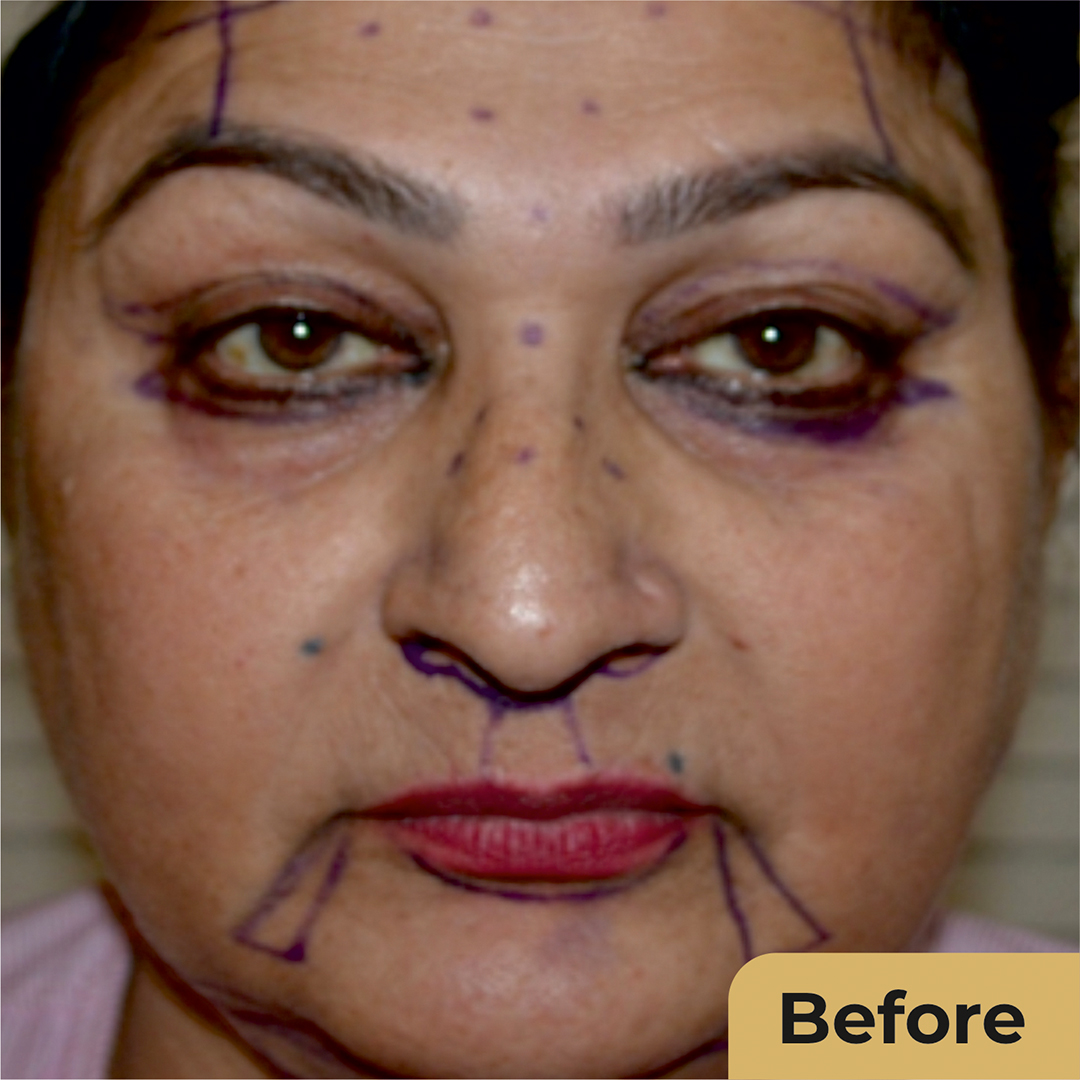
Facelift Surgery in Vadodara

Facelift surgery in Vadodara, also known as rhytidectomy, is a cosmetic procedure designed to restore a more youthful appearance by tightening sagging skin, smoothing deep folds, and lifting facial tissues. At Krisha Hospital, we use advanced surgical techniques to enhance your facial contours and redefine the jawline.
Often combined with neck lift procedures, a facelift addresses visible signs of aging on the face and neck. Whether you’re dealing with wrinkles, sagging cheeks, or loose skin, this surgery can dramatically rejuvenate your appearance. It offers long-lasting results with a high facelift success rate when performed by expert surgeons.
Facelift surgery in Vadodara is ideal for men and women experiencing visible signs of aging such as sagging skin, deep lines, jowls, and loss of facial volume. If you’re generally healthy, do not smoke, and have realistic expectations about the outcomes, you are a suitable candidate. Individuals seeking a facelift for youthful appearance, especially those in their 40s to 60s, can benefit significantly.
It is especially effective for patients whose skin still retains some elasticity. A facelift consultation in Vadodara at Krisha Hospital helps determine if you’re a good fit for this procedure and whether you might benefit from combining it with neck lift surgery.
Facelift surgery in Vadodara at Krisha Hospital delivers remarkable and natural-looking results. It effectively reverses signs of aging by tightening sagging skin, redefining facial contours, and smoothing wrinkles. Patients experience a rejuvenated, youthful appearance that can last for years. The facelift for youthful appearance helps restore confidence and enhances facial harmony.
With advanced techniques such as SMAS reconstruction and optional facelift with neck lift, the final outcome is subtle, not stretched, providing a refreshed and revitalized look. You can also view facelift before and after photos to see real transformations achieved at our clinic.
The typical facelift recovery time is around 7 to 14 days. Patients can usually resume daily activities within one week, though strenuous work or workouts should be avoided for a few more weeks. Swelling, bruising, and mild discomfort are common in the initial days but subside gradually with proper care. Stitches are removed between the 5th and 10th day.
Our team provides detailed aftercare guidelines and follow-up checks to monitor healing. Full recovery and final results may take several weeks to become fully visible. Personalized care ensures an optimal facelift success rate with minimal complications.
The typical facelift recovery time is around 7 to 14 days. Patients can usually resume daily activities within one week, though strenuous work or workouts should be avoided for a few more weeks. Swelling, bruising, and mild discomfort are common in the initial days but subside gradually with proper care. Stitches are removed between the 5th and 10th day.
Our team provides detailed aftercare guidelines and follow-up checks to monitor healing. Full recovery and final results may take several weeks to become fully visible. Personalized care ensures an optimal facelift success rate with minimal complications.
Like any cosmetic procedure, facelift surgery in Vadodara comes with potential risks, including swelling, bruising, temporary numbness, infection, scarring, or bleeding. Rare side effects might include facial asymmetry or skin irregularities. However, choosing the best facelift clinic in Gujarat significantly reduces these risks. At Krisha Hospital, surgeries are performed under strict medical protocols using advanced techniques.
To stay safe, avoid smoking, follow pre- and post-operative instructions, and attend all scheduled follow-ups. Consulting with an expert ensures the safest outcome, especially for facelift for men and women of various ages and skin types.



EXCELLENTTrustindex verifies that the original source of the review is Google. Krisha hospital ma me brest size mate consulting karyu d .r rajnikant sir jode Mane ghanu saru samjavyu chhe thanks sirPosted onTrustindex verifies that the original source of the review is Google. Me krisha hospital ma hair fall ni treatment lidhi chhe mane ghanu saru result madiyu chhe thanks for krisha hospitalPosted onTrustindex verifies that the original source of the review is Google. Very nice Krisha Hoshpital na all's Sister and Doctor Rajanikant parmar aap shau a mane bahuj sharsh halp Sarwish aapi mane Pahela karta atiyare bahuj sharu fil thay che Thank u so much doctor &shatap Shalam che tamne Doctor Rajanikant shahenPosted onTrustindex verifies that the original source of the review is Google. Really happy with service. One of the best clinicPosted onTrustindex verifies that the original source of the review is Google. Amazing worked on my face by rajnikant sir.. I have many stitches on my face but after recovery no marks on my face.. Thank you very much..Posted onTrustindex verifies that the original source of the review is Google. Krisha hospital me mene skin glow ke liye haydra facial karvaya tha nice result Thanks sir & staffPosted onTrustindex verifies that the original source of the review is Google. All cosmatic surgerys are excellent specially Hair Transplant & Tummy TuckPosted onTrustindex verifies that the original source of the review is Google. Mene Hair Transplant Surgery Karvai he or mujhe bohot excellent result Mila he or me or bhi loggo prefere karunga So thank uuu krisha hospitalPosted onTrustindex verifies that the original source of the review is Google. Best Hair Transplant & Hair Loss Surgery In Vadodara City
Facelift surgery in Vadodara is a cosmetic procedure designed to reduce visible signs of aging by tightening facial muscles, removing sagging skin, and restoring facial contours. At Krisha Hospital, our specialists use advanced techniques like SMAS lifting and platysmaplasty to achieve long-lasting, natural results. Incisions are discreetly made near the ears or hairline, and the skin is repositioned without stretching, ensuring a rejuvenated, youthful appearance.
Krisha Hospital is widely recognized as the best facelift clinic in Gujarat. With expert surgeons, state-of-the-art technology, personalized care, and high patient satisfaction rates, we specialize in delivering safe and aesthetic facelift results tailored to individual facial structures.
The facelift cost in Vadodara depends on the extent of correction needed, the technique used, and whether it’s combined with other procedures like a neck lift. At Krisha Hospital, we offer transparent pricing with premium care. A personalized quote is provided during your facelift consultation in Vadodara.
Absolutely. Facelift surgery for youthful appearance is highly effective in tightening sagging skin, reducing wrinkles, and improving jawline definition. It restores a fresh, natural look that boosts self-confidence without drastically changing your facial identity.
Yes, we provide facelift before and after photos during your consultation. These real-life examples help patients understand expected outcomes and the quality of results delivered by our expert team.
You can find expert facelift surgery near you in Vadodara at Krisha Hospital, conveniently located and equipped with modern facilities to ensure your comfort, safety, and satisfaction throughout the surgical journey.
Facelift recovery time typically ranges from 7 to 14 days. Most patients return to light activities within a week. Swelling and bruising are common but subside gradually. Full healing and final results can take several weeks, and detailed aftercare instructions are provided.
Common facelift side effects include swelling, bruising, temporary numbness, tightness, and mild discomfort. Serious complications are rare but may include infection or asymmetry. At Krisha Hospital, strict medical protocols ensure a high level of safety and care.
Booking your facelift consultation in Vadodara is easy. Simply visit our official website or call our clinic to schedule a one-on-one session with our expert surgeon for personalized advice and treatment planning.
Krisha Hospital has a high facelift success rate due to skilled surgeons, modern techniques, and personalized pre- and post-operative care. Most patients report long-lasting, natural results and high satisfaction with their youthful transformation.
Yes, facelift surgery for men and women is equally effective. Procedures are customized to enhance natural features while respecting gender-specific aesthetics, making it suitable for adults experiencing facial aging regardless of gender.
Yes, a facelift with neck lift is a common and highly effective combination. It addresses sagging in both the lower face and neck area for a more harmonious and complete rejuvenation. This combined approach is often recommended for enhanced, longer-lasting results.

